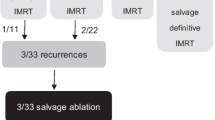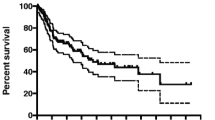Purpose:
To evaluate the clinical outcome of intensity-modulated radiotherapy (IMRT) in patients with mucosal melanoma (MM) of the nasal cavity and paranasal sinuses.
Patients and Methods:
Between January 1999 and September 2004, eight patients with histologically proven MM of the nasal cavity and paranasal sinuses were treated with IMRT. A median dose of 66 Gy was applied to the macroscopic tumor (gross tumor volume [GTV]; range, 60–68 Gy) as an integrated boost and a median dose of 59 Gy (range, 54–64 Gy) to the clinical target volume (CTV) with IMRT.
Results:
Treatment-related toxicity was very mild in most patients. Overall survival was 80% at 5 years. Calculated from treatment with IMRT as primary radiotherapy, survival was 100% at 1 year and 75% at 3 years. After IMRT, local progression-free survival was 71.4% at 1 year and 57.1% at 3 years, respectively. Distant progression-free survival after IMRT was 57.1% at 1 year and 28.6% at 3 years.
Conclusion:
Local dose escalation with IMRT yields good treatment results with respect to local and distant tumor control as well as survival, while treatment-related toxicity can be minimized.
Ziel:
Evaluation der klinischen Ergebnisse der intensitätsmodulierten Strahlentherapie (IMRT) bei Patienten mit Melanomen der Nasenhaupt- und Nasennebenhöhlenschleimhaut.
Patienten und Methodik:
Zwischen Januar 1999 und September 2004 wurden acht Patienten mit histologisch gesicherten Schleimhautmelanomen der Nasenhaupt- und Nebenhöhlen mit IMRT behandelt. Es wurden eine mediane Gesamtdosis von 66 Gy auf den makroskopischen Tumor („gross tumor volume“ [GTV]; Spannbreite 60–68 Gy) als integrierter Boost und eine mediane Dosis von 59 Gy (Spannbreite 54–64 Gy) auf das klinische Zielvolumen (CTV) mittels IMRT appliziert.
Ergebnisse:
Die Nebenwirkungsrate war sehr gering. Das Gesamtüberleben betrug 80% nach 5 Jahren. Berechnet von der Initiierung der IMRT als primäre Radiatio, betrug das Überleben 100% nach 1 Jahr und 75% nach 3 Jahren. Nach der IMRT lag das lokale progressionsfreie Überleben bei 71,4% nach 1 Jahr und bei 57,1% nach 3 Jahren. Das distante progressionsfreie Überleben nach IMRT betrug 57,1% nach 1 Jahr und 28,6% nach 3 Jahren.
Schlussfolgerung:
Die lokale Dosiseskalation mittels IMRT führt zu guten Behandlungsergebnissen im Hinblick auf Gesamtüberleben und lokale Tumorkontrolle, während das Risiko für radiogene Toxizitäten minimiert werden kann.
Similar content being viewed by others
Author information
Authors and Affiliations
Corresponding author
Rights and permissions
About this article
Cite this article
Combs, S.E., Konkel, S., Thilmann, C. et al. Local High-Dose Radiotherapy and Sparing of Normal Tissue Using Intensity-Modulated Radiotherapy (IMRT) for Mucosal Melanoma of the Nasal Cavity and Paranasal Sinuses. Strahlenther Onkol 183, 63–68 (2007). https://doi.org/10.1007/s00066-007-1616-2
Received:
Revised:
Issue Date:
DOI: https://doi.org/10.1007/s00066-007-1616-2




